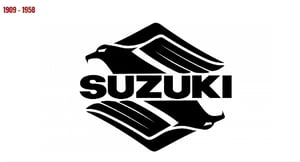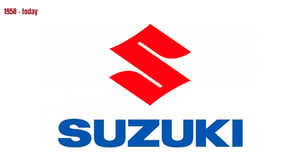.png?width=1200&height=628&name=H%26D%20%20Blog%20Header%20Template%20%202022%20(34).png)
In New Zealand, whether it’s a motorcycle, car or outboard, you would have likely heard of Suzuki. You may even own one, have owned one, or at the very least heard a tall tale or two from someone who has.
Having been around for over a century, this global company is well known for its quality, affordability and efficiency. Suzuki’s quirky and efficient cars, rough’n’tough 4WDs, top-performing motorcycles and innovative marine technology are everywhere you look.
Take a moment to discover these ten interesting facts that you might know about this fun, adventure-loving brand.
1. Introducing Michio Suzuki
A quick overview of Suzuki car models history is a great place to start.
The company's founder, Michio Suzuki, was born and raised in Nezumino-mura, a fishing village close to where the head office is now located in Hamamatsu, Japan. Cotton weaving was the main economic activity here, so it makes sense that his first invention was a wood and metal floor loom to help his mum.
It was ten times more efficient than previous looms, so Michio went commercial, and in 1909, he founded Suzuki Loom Works. He later founded the Suzuki Loom Manufacturing Co. in March 1920, which eventually went beyond innovative loom mechanisms to manufacturing motorcycles, outboard motors, and vehicles.
Michio Suzuki didn’t attribute his success to his genius. Instead, he implemented a number of important changes by listening to his customers. He created his inventions by paying attention to their needs and problems, holding over 120 engineering patents for other helpful inventions.
2. Learn About the First Suzukis
Suzuki joined the transport scene by launching the two-cycle auxiliary bicycle engine Power Free 36cc in 1952. The company released "Colleda", the 125cc motorcycle, three years later. However, it was the pioneering Suzulight minicar, released in 1955 that really boosted his home country's automotive revolution. In 1965, Suzuki released its first two-cycle, 5.5hp outboard motor dubbed the D55.
Currently on the autos side, Suzuki produces some of NZ’s favourite models, including:
3. The Iconic Suzuki Logo Hasn't Changed Much
The company unveiled its iconic "S" logo on 1st October 1958; a unique symbol that mirrors Japanese traditional symbolism, like the curving shrine roofs and the tip of Japanese swords. The designer, Mr Masamichi Tezeni, later gained recognition for his role in designing the bullet train, called the Shinkansen.
The company has kept the name of its founder since the very beginning and interestingly "Suzuki'' is Japan's second most common family name.
The brand's colours symbolise Michio Suzuki’s birthplace; the Suzuki red is symbolic of Japan, while the Suzuki blue represents the water bodies in the Enshu region, including Lake Hamana, Enshunada, and Tenryu River.
Originally, the logo was designed with the letter "S" in the shape of an eagle, with the word Suzuki passing through the middle section in black. Unlike other manufacturers, the emblem hasn't changed much in the last 65 years, settling on the iconic red ‘S’ and the blue Suzuki.


4. Suzuki is Popular Worldwide
The company celebrated ’100’ in March 2020 and is home to over 69,000 workers working in 33 production facilities in 21 countries around the world. Suzuki has 144 distributors in 208 nations, including Australia and New Zealand, who help provide people with a wide range of motorcycles, automobiles, outboard motors, and even motorised wheelchairs to get around in.
5. Suzuki Has Been Around a Long Time in New Zealand
Suzuki began in New Zealand with the Coleman family and South Pacific Suzuki Distributors in 1965. This local company initially ran a vehicle and motorcycle assembly plant, but the dynamics of the New Zealand market caused the local assembly to come to an end. In 1984, Suzuki Motor Corporation in Japan, bought the Coleman family out and formed what is operating today - Suzuki New Zealand Ltd.
New Zealand's Suzuki head office is still in Whanganui today, and is home to over 50 employees. It continues to import and distribute to the nationwide dealer network a range of Suzuki cars, motorcycles and outboards for everyday Kiwis.
6. Suzuki is Really Big in India
Suzuki entered the Indian automobile sector in the early 1980s, working with the Indian Government to found Maruti Udyog Ltd and establish the first manufacturing factory in Gurugram, Haryana.
From the first production came the Maruti 800, also called the Suzuki Alto or Fronte. Making affordable cars was the primary objective and the rapidly growing middle class provided a golden opportunity for it to become the country's top automaker.
By 2007, the Indian Government sold all of its remaining shares to Suzuki Motor Corporation and the company was renamed Maruti Suzuki India Ltd.
Currently, India is the company's largest market, producing over 2.5 million automobiles annually, more than twice the production in Japan! This is a market share of about 40% in the passenger car market. There are three manufacturing plants in India and another in the pipeline, who supply not only the local market but also export to other regions, such as South America, Africa and Australasia.
7. It Takes Just 2,545 Steps to Complete a Suzuki Car
Suzuki owes a big part of its success to its efficient practices based on the principles of ‘Sho-Sho-Kei-Tan-Bi’ or Smaller, Fewer, Lighter, Shorter and Neater. It takes just 2,545 human steps to complete a Suzuki car, with the help of clever robots, kms of conveyor belts, and an efficient just-in-time delivery system of the various parts.
Suzuki’s clever production planning system uses technology to eliminate margin for error, creating a consistent and very high degree of precision and output.
For example, there are 7,000 workers, 1,100 robots, and 10 km of running conveyor belts in the Maruti Suzuki Manesar plant. The staff and robots can manufacture up to 3,100 vehicles a day with an assembly line stoppage of under 1.8 minutes and 98% efficiency.
8. Suzuki Love Small and Really Small Cars
There’s no doubt that Suzuki does ‘small cars’ well.
In New Zealand, the Suzuki Swift has been the number one small car for 17 of the last 18 years. It’s fun, super-efficient, affordable, and comes in a small and easy to handle size, making it universally appealing to all sorts of Kiwis.
In Japan, some of the most-popular and smallest road-legal cars are kei cars (short for ‘keijidōsha’ or ‘light automobile’). Originally created by the Japanese government in 1949, kei cars, like the Suzuki Hustler or Lapin, are currently classified by a maximum vehicle size of 3.4m long by 1.48m wide, engine capacity of 660cc, and 47 kW power output, providing owners with tax and insurance benefits.
You will see a lot of Suzuki kei cars in rural areas where public transport systems aren’t as good and where the roads are only wide enough for two kei cars to pass. They are also exempt from having to certify that adequate parking is available for the vehicle.
9. Suzuki Is on the Way to the Moon
One of the most notable Suzuki partnerships is the collaboration with ispace’s HAKUTO-R, the world’s first commercial lunar exploration programme.
Suzuki is offering its structural analysis expertise used in the testing of its automobiles, for the development of the HAKUTO-R lunar lander, including the lander’s landing gear, such as the shock-absorption system of the lander’s legs.
You can stay up to date with the latest missions, here.
10. Suzuki for the Future
Like other manufacturer’s, Suzuki is working on new products and processes to reduce carbon emissions, outlining their plans in its 2030 Growth Strategy.
This includes developing six electric vehicles for Japan, five electric vehicles in Europe, and a mixture of electric, CNG and biogas options for India.
To counterbalance economic growth in India, Suzuki is researching the unique approach of producing and supplying biogas derived from cow dung in India’s rural areas. This biogas can then be used for Suzuki’s CNG models that account for 70% of the CNG car market in India.
Suzuki is also looking to strengthen its co-operative initiatives with Toyota, who own a 4.9% share in Suzuki, as well as electrify its motorcycle and outboard motor products.
Other initiatives and partnerships include working with Applied EV on an autonomous electric vehicle platform, PowerX on EV charging and battery energy storage systems, and SkyDrive and the development of ‘flying cars’.
Suzuki’s ongoing success can be traced back to its long history of innovation and listening to the needs of their valued customers. Hopefully you learned a few interesting facts, and maybe they’ll come in handy for the next quiz night!
If you’re on the hunt for the perfect Suzuki for your day-to-day life, take a look at all the options available in our Guide to Buying a New Car today.




